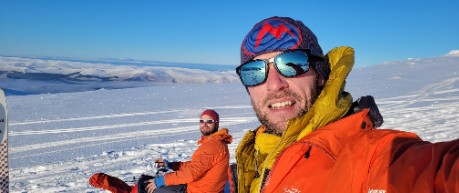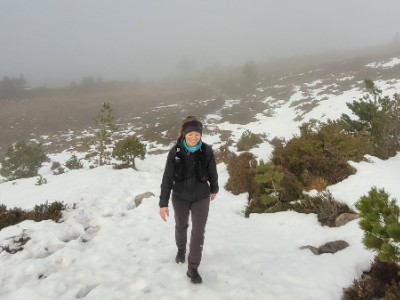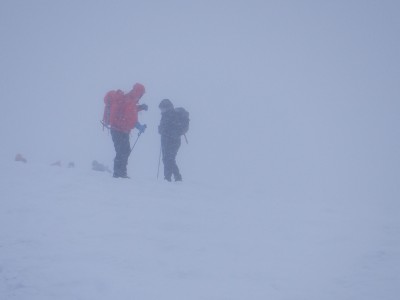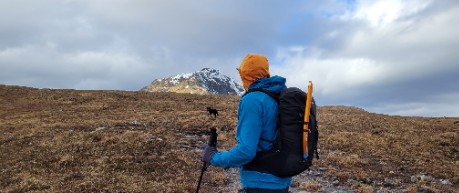Thursday 16th May 2024, 9:14am
Mountain Safety Advisor Ben Gibson takes a brief look back over the past winter season (Dec 23 Ė April 24) and shares the lessons he has learned from delivering Mountaineering Scotlandís winter courses and from his own personal experiences, while looking at what can be taken forward to the next winter seasonÖ
Has this winter been any different to past winters? Has it felt more challenging? Has there been overall more/less snowfall and more/less consistent snow days than previous seasons?
If we look back to the 2021/22 winter season (SAIS Winter Report), it was described as a Ďlow snow yearí with limited periods of a Ďproper winterí with frequent storms and on average (throughout the UK) there has been an increase in average mean winter temperatures (Met Office data between 1991-2020).
Astronomically and Meteorologically winter is over, although snow can still be present in the higher hills and sun sheltered locations late on into the year and winter can sometimes feel like it stubbornly sticks around! It has certainly felt more stormy than previous years with what seemed like more stormy and windy days.

Changeable conditions

In comparison to last year, when were just two named stormed events from the Met Office, this year has seen 10 so far, with six of those being between December 2023 and end of January 2024.
With what has felt like more days with stronger winds, warmer temperatures and less snow, winter has been challenging in both getting out to play and to deliver courses in winter skills and mountaineering. It is easy to forget, however, that winter is not just about having snow on the ground but is a period when days are shorter, colder, wetter, windier, more changeable, and generally more challenging when it comes to planning mountain adventures. With that said, has this winter felt or been any different to winters past? I would say yes and no!
Why? Personally and in a working capacity, it has felt that there were more days spent staying at lower elevations and finding suitable safe working venues out of the strong winds, as well as finding workable snow patches or areas of snow that donít put you in steep consequential terrain, which you can often find yourself in very quickly if not alert to changes in aspect and angle of terrain! This is more difficult when the weather is against you with limited and poor visibility.
Scarcity of snow certainly has been a problem to provide the best training possible. Ideally, progressing skills through a varied terrain journey makes more sense than finding a small garden sized patch of snow, which everyone wants to use as conditions limits widespread cover! Again, this highlights less consistent snow days and terrain choices that donít put you or a group into very steep terrain!
Looking ahead to the next winter season with what I learned from this winter, here are a few thoughts about what I would change/modify in my behaviours and also what I would carry out on the hill.

Being openminded and adaptable in plans for any day out:
Not forcing a journey to happen if the avalanche and weather forecast are fighting against you. Be patient and planning for several options (possibly in different mountain areas) that can work for the conditions, for example having a few lower-level walks that you can still get out practicing navigation, snowcraft or just building up some resilience to the winter conditions.
Double check your kit the night before!
Never presume your kit just works. Check crampons are fitted properly to boots, headtorches are charged (or have good batteries), youíve got your spares (gloves, hat, etc), first aid kit, bivy bag and/or group shelter.
There have been a few days when out and found that in a group someoneís crampons werenít fitted properly or rusty and almost unusable from just presuming, they were okay from the last time they had them out (which may have been a month or more). I made this mistake too from not fitting my crampons properly after being used on a different pair of boots and made for an awkward faff in very challenging conditions.
Carrying and extra map and compass!
Iíve managed many winter seasons without losing a map or breaking a compass but, it happened this year and I reversed the polarity in a compass! Also, making sure that as a group everyone is carrying their own navigation tools. This season also saw a few separate incidents where independent groups became separated and misplaced from each other when but thankfully had map and compass to sort themselves out, relocate and either walk off or call for help.
Donít skimp on a big group shelter!
I always carry a group shelter when out as a pair or in a larger group. I learnt this winter that if itís a 4Ė6-person shelter, itís a squeeze and not the most comfortable space to hide in! In a group of 6 ideally it needs to be an 8 person or more to accommodate everyone.
The extra weight of a warm drink is worth it!
I rarely used to take a hot drink out on the hills in winter as was in that mindset of not wanting to carry extra weight of a flask and weight of liquid. This will change for next winter as having shared a hot juice and feeling my bones being rewarmed on a very cold winter belay was worth its weight in gold!
If I donít know, I know I shouldnít go!
Going out in winter has its higher level of hazards and risks associated with it in relation to planning on how to avoid avalanche terrain. My risk tolerance levels have changed over the years through experience and time spent in the environment and I know enough to know when I donít know enough about conditions, avalanche hazards, weather, personal or group ability I am in a more comfortable position to change and adapt plans or just turn around and find the nearest coffee shop!
We often base these decisions on Ďbad luckí however, it was the best decision to make at the time when you didnít have all the information to proceed on your journey. Use these opportunities to expand your knowledge and gain stronger experiences that will help in future adventures!
If youíre thinking it, say it!
This is a great mantra to have within a group of friends, peers or even a guided group. If you see something or think about some uncertain information or observation about terrain choice, avalanche conditions, weather, and group ability Ė donít keep it to yourself! Verbalize what youíre thinking, which will hopefully prompt others to see similar and allow for a chat about conditions.
I started to use the phrase: ďíBecause Iím thinking it, Iím going to say itĒ. This has helped in getting a friend or a group to see the same information and not hold back on what could be key information if we hadnít realised our proximity to an avalanche prone slope, heading off the wrong direction on a compass bearing or putting crampons on earlier before getting into steeper consequential terrain.
This process starts at home and if youíve put enough time and effort into planning a day out on the hills, then hopefully nothing should be of surprise or catch you out because you have recognised this through planning.
If there is a level of uncertainty that you are caught out by this is an opportunity to have a think about why itís a surprise and act on it by asking relevant questions to the current avalanche and weather conditions to see if anything has changed, which could affect your day. The Be Avalanche Aware checklist is a great resource to help with this process starting.

Mountaineering Scotland and our Mountain Safety Group partners would like to ask for your helping in finding out more about how people are using crampons, microspikes or other traction devices when out in the winter hills...and what is influencing their decisions on when to use them.